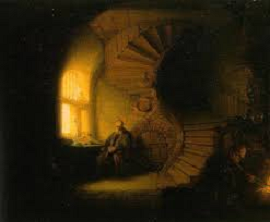
Life and contemplation
No, it is not about the art of observing nature or the universe, as the act of observing is also an “active life” as there will certainly not be any interpretation or detail that catches our attention.
universe, as the act of observing is also an “active life” as there will certainly not be any interpretation or detail that catches our attention.
It is about other meanings: listening without interpreting, looking with a purified gaze and understanding what is incomprehensible to human reason, so it is not a rational attitude, nor a madness or sensitive delirium, it is an exercise of “inactivity” writes Byung- Chul Han.
The author writes in Vita Contemplativa: ou sobre a inativa (Han, 2023, p. 11): “Inactivity constitutes the Humanum. What makes doing genuinely human is the amount of inactivity in it. Without a moment of hesitation or restraint, acting degenerates into blind action and reaction. Without rest, a new barbarism emerges.”
Therefore, contemplative inactivity is not to be confused with laziness, absence of action, but a rest for clairvoyant action and deep speech, says the author: “It is silence that gives depth to speech. Without silence there is no music, but only noise and noise. Play is the essence of beauty. Where only the scheme of stimulus and reaction, of lack and satisfaction, of problem and solution, of objective and action, prevails, life is reduced to survival, to naked animal life” (idem) and it is not by chance that it is confused with current modern life.
We are not machines always destined to function, the true life of conscious action begins when the concern for survival ceases and the need for raw life is born.
The confusion appeared because of the confusion between history and culture, not the history of ideas (in the sense of the Greek eidos), but that which ignores culture and deals only with the power and oppression of peoples, says the author: “action is, in fact, constitutive for history, but it is not the formative force of culture” (Han, 2023, p. 12) (paint: Contemplation of philosopher, Rembrandt, 1632).
And he adds in the same passage: “Not war, but celebration, not weapons, but jewelry, are the origin of culture. History and cultural do not coincide” (Han, idem).
“Jewelry” may seem strange, but the core of our culture is ornamental. It is situated beyond functionality and utility. With the ornamental that is emancipated from any purpose or utility, life insists on being more than survival” (idem).
The great religions have established the sacred in inactivity: Christian Sunday, the Jewish Sabbath, Islamic Ramadan, these are not just about inactivity, but a day of “contemplation”.
The “active” man searching for an “intense” and unbridled life of stimuli and responses falls into a void of meaning and into merely fighting for survival, little or nothing human resists, and if we want to return to the civilizing process, culture, the ornamental and the party must return to everyday life, time for Christmas and end-of-year celebrations, time to stop.
HAN, B.C. (2023). Vita Contemplativa: In Praise of Inactivity, transl. Daniel Steuer, USA, ed. Polity.









